We have a reprint of an article on the Argentine Halcon SMG written by Ronaldo Olive, originally published in Gun Tests in the early 90s. These are pretty tough guns to find information on (especially for us norteamericanos), and Ronaldo has done an excellent job of explaining the different models and their development – thanks Ronaldo!
Argentine SMGs
Called the “Falcon” family, these little-publicized subguns are still on duty with local polices forces
by Ronaldo Olive; photos by Ronaldo and Felipe Olive
Countless nations around the world have, of course, submachine guns in the inventories of their respective military and police forces. But not that many can boast possessing weapons of really indigenous design and manufacture. Among the lesser known of this group is the South American country of Argentina.
It is a sure bet that the mention of Argentina may prompt the average reader to think of fine beef or the charming tango dance, as opposed to guns in general, and even less submachine guns. Still, for the last half century or so the Argentines have not only been designing but actually producing subguns for their own use.
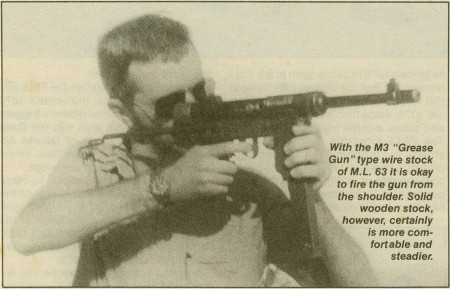
The whole thing kicked off in 1930, when Juan Lehnar put together the very first SMG to be devised in that part of the world. It was a selective-fire weapon employing 9mm Parabellum ammunition fed by a curved magazine on the left side of the receiver (the magazine well could be turned upwards to make the gun flatter, for transport). The metal stock could be swung forward, thus reducing the gun’s length from 700mm/27.5″ to 290mm/11.75″, and the wood foregrip could be moved to lie flat under the forward end of the receiver. A single prototype was built.
First Factory
A whole decade would elapse before things got started again. In 1941, Fábrica de Armas Halcón (Falcon Gun Factory) was established in Buenos Aires to develop a number of small arms projects, including that of submachine guns. They varied considerably in appearance, but have been generally referred to as the Halcónes (Falcons).
The first was the Modelo 1943 in .45 ACP caliber, for a long time employed by the “Gendarmeria Nacional” (National Police). Its appearance was definitely unmistakable, mainly due to the fluted, all-finned barrel with a massive compensator at the muzzle. Feeding was by straight box magazines of 17- or 30-round capacity that inserted into a housing that doubled as a foregrip. The fire selector was a button of the push-through type found directly above the trigger, working just like that of the British STEN (pushed in from the left side, fire was semiautomatic; full-auto was the other way around).
The next variation was the Modelo 1946, in the same caliber, which was known as the “Modelo Aeronautica” (Air Force Model) to refer to its intended use. Although the action was virtually unchanged compared to the earlier version, a number of modifications were to be found: a folding metal stock (allowing reduction of the overall length from 790mm/31″ to 520mm/20″), a shorter barrel (from 292mm/11″ to 152mm/5.75″) with a simplified compensator, the addition of a rear pistol grip, and the elimination of the forward grip proper (the magazine itself was used as such).
A switch to 9mm Parabellum caliber was one of the items that distinguished the Modelo 49, or “Modelo Ejercito Argentino” (Argentine Army Model), which returned to the earlier wooden stocked configuration. A curved 36-round magazine was introduced, and its housing/forward grip was enlarged at the bottom to facilitate insertion. Apart from other minor changes, the Halcón maintained other peculiar – but definitely unwanted – properties: it was still too complicated and expensive to make, as well as bulky.
Simplified Models
In the mid fifties, the company designers decided to depart from the previous generation concepts and embark on a program to develop a simplified gun, that is, functional and inexpensive to manufacture. The result was the “Modelo Liviano 57” (Light Model 57), a far cry in appearance from the previous Halcónes.
Lighter it was, at an empty weight of 3.25kg (7.26lb) compared to the 4.75kg (10.5lb) of the Modelo 1943 and the 4kg (9lb) of the Modelo 1946. The weapon made extensive use of sheet metal stamping techniques, being slightly more than a long metal tube with a pistol grip assembly (where the firing mechanism was accommodated) and a housing for the curved 40-round magazine attached to it. At the opposite ends, there were a 225mm-long (8.85″) barrel and an extremely spartan metal stock, which could be swung upward and forward to lie flat on the left side of the receiver (length reduction: from 780mm/31″ to 535mm/20″).
The previous model’s safety (a lever on the left side, above the trigger) gave way to a notch in the rear of the cocking piece slot, into which the handle hooked after the bolt had been retracted. Apparently, there was no way of locking the bolt in the forward position, a definite danger to a simple blowback action subgun. The fire selector lever was located on the left side of the pistol grip, whose corresponding panel was shaped so as to allow the lever to turn.
A further variant was the “Modelo Liviano 60”, which let go of the fire selector lever and used a dual trigger arrangement, in which the forward trigger gave semi-automatic fire and the rear one was for full-auto. In other respects, the two Light Models were twins.
Unconfirmed estimates are that a combined total of no more than about 10,000 of these Halcónes were manufactured. It should also be pointed out that several prototype guns were built over the years, and those had a mixture of experimental features.
Still Going Strong
But don’t think that the Argentine Falcons are no longer “flying high” in the country. There is one variety in current use with the police (as of the early 1990s, when this was written – Ian), in spite of having celebrated its silver jubilee. It was the final design to materialize from the Buenos Aires company, which, incidentally, was renamed Metalurgica Centro in the mid-sixties.
Designated ML63 (Modelo Liviano 63), it is a conventional blowback operated gun that atypically fires from the closed-bolt position only.It exists in both fixed wooden stock and sliding wire stock versions, and I was kindly allowed by the Argentine Federal Police to fire each informally during a familiarization session, under the supervision of local gun expert Pantaleón Kotelchuk.
With an empty weight of 3.7kg (8.25lb) this Halcón has an overall length of 690mm (27″), which comes down to 500mm (19.5″) when you retract the M3 ‘Grease Gun’-type stock. The magazine for the 9mm Parabellum ammunition is of the smooth-operating (and easy hand-loading) two-position feed type, and is inserted into a forward grip. The small catch is situated at the rear end, being pushed forward to release the magazine – and easy single-handed operation.
Although the cocking handle lies 90 degrees to the right side of the receiver, yours truly found no big deal actuating it with the left hand, without loosening the grip. The applied safety is a sliding lever on the left side, above the well-raked and comfortable pistol grip, which blocks the trigger action. A secondary (automatic) safety engages the hammer if, for example, the cocking piece is accidentally released before the stroke is completed.
The rear sight is of the flip type, with notches for the usual 50- and 100-meter ranges, while the blade foresight sits on top of the compensator (the same as the earlier ML 57/60). Although the ML63 employs a different trigger mechanism, the dual-trigger system is retained, with separate triggers for semiauto (front) and full automatic (rear) fire. Although being a straightforward mechanical solution, like everything else in life one must get used to it until the action becomes natural. By the end of my short shooting session I was still hesitating between triggers, but the local officers told me it has become second nature to them.
I found the Halcón a delight to shoot, especially the fact that it fires from a closed-bolt position in semiautomatic, thus eliminating that unavoidable jolt of the bolt displacing forward immediately prior to Bang! There’s no denying that the open-bolt system is a simpler firing system for an SMG. Also, it helps prevent “cook-off” incidents – in which a too-hot barrel causes the combustion of the cartridge’s powder – by keeping the action open and more ventilated between shots might be a fact of life…if the average user were carrying enough ammo to fire continuously, which is certainly not the case outside endurance testing facilities.
In any case, the steadiness of the ML63 in single shots is certainly an asset, mainly for the often ignored use of subguns in “surgical” (maximum precision) roles. I was shooting at an indoor range of about 25 meters, and consistently placing hits on the heads of standard-size silhouettes was a piece of cake.
I am one of those who favor slow-to-moderate rates of fire for submachine guns, and thus gave the Argentine weapon an “A” in this department. Bullets come out of that 170mm (6.7″) long barrel at 600 per minute, muzzle velocity being in the region of 350m/s (1070fps). That compensator adds somewhat to the stability…and noise, the two longitudinal slots on top making the shooter fully aware that hot gasses are being deflected upwards less than away.
The Halcónes are gradually being replaced by another submachine gun of local manufacture, the FMK-3 of the State-owned military factory “Domingo Matheus.” But I can bet they will still be around, in secondary duties, for several more years to come. Falcons are tough birds…
Technical Specs
| Lehnar prototype | M1943 | M1946 | M1949 | ML57/60 | ML63 | |
| Caliber | 9mm Para | .45 ACP | .45 ACP | 9mm Para | 9mm Para | 9mm Para |
| Magazine Capacity | 30(?) | 17 or 30 | 17 or 30 | 36 | 40 | 42(?) |
| Barrel Length | 292mm 11in |
152mm 5.75in |
292mm 11in |
225mm 8.85in |
170mm 6.7in |
|
| OAL (stock extended) | 700mm 27.6in |
790mm 31.1in |
780mm 30.7in |
690mm 27.2in |
||
| OAL (stock folded) | 290mm 11.4in |
520mm 20.5in |
535mm 21.0in |
500mm 19.7in |
||
| Weight (empty) | 4.75kg 10.5lb |
4.0kg 9.0lb |
3.25kg 7.25lb |
3.7kg 8.25lb |
||
| Trigger type | Single | Single | Single | Single | Single (ML57) Double (ML60) |
Double |
| Firing position | Open bolt | Open bolt | Open bolt | Open bolt | Open bolt | Closed bolt |
Manuals
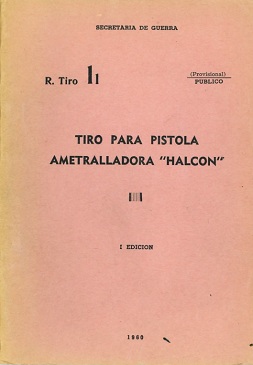

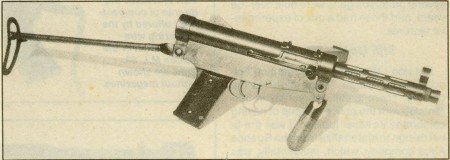
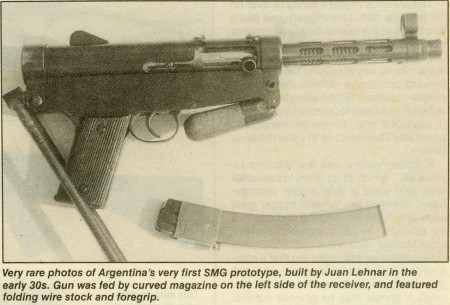
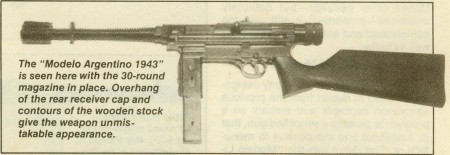
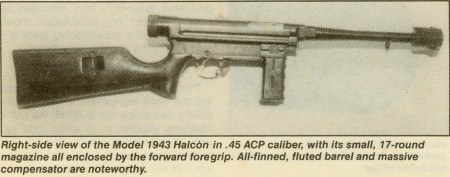
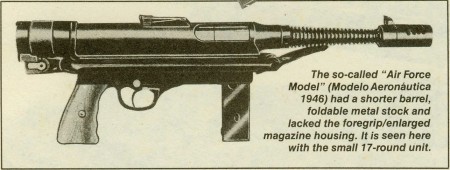
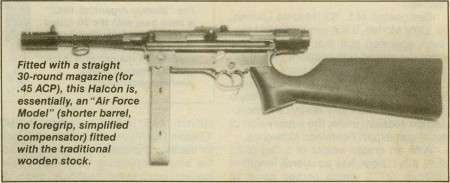
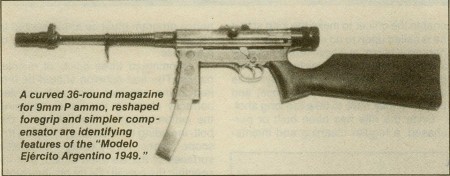
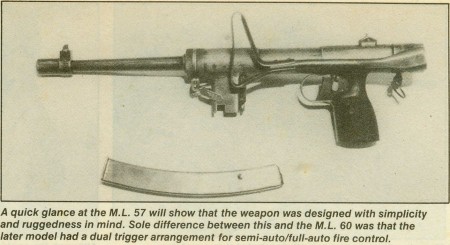
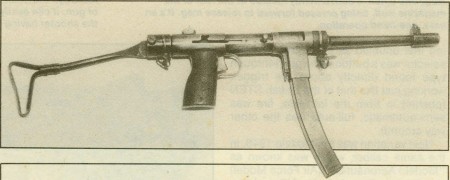
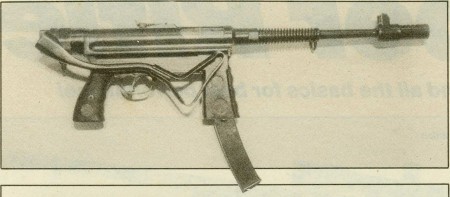
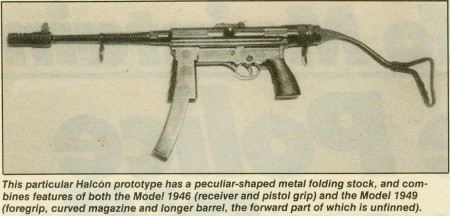
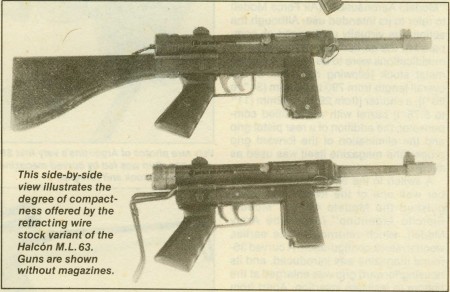
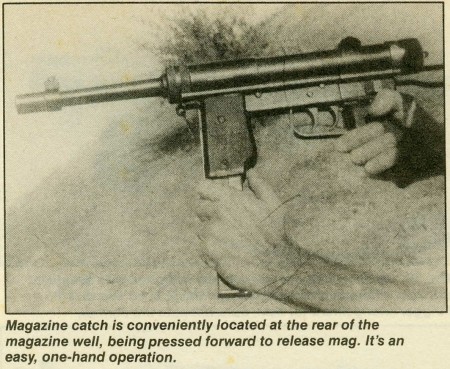
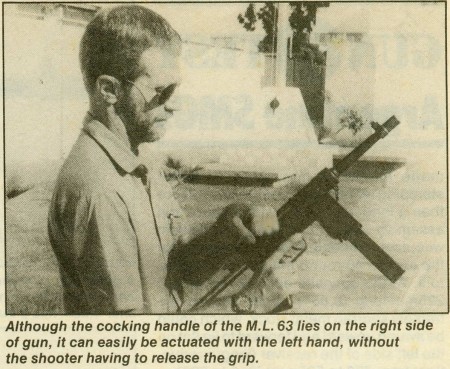
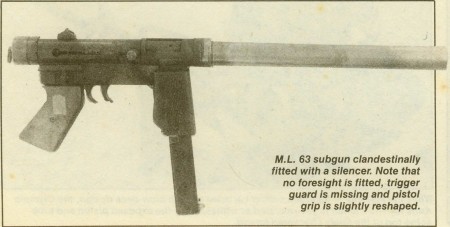
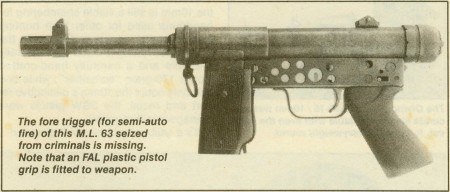
Wonderful looking gun by design, appears to be the any man’s gun for any situation. Granted, it must be customized to the chaos the user would bring the gun towards, albeit before any bullets fired as well. Thanks for introducing me to this, I was going to use the STEN with a built in front folding grip.
Also, I am searching for a specific, special M1897 in design that had the heat guard extend over and up to the tip of the barrel. A bayonet could also be attached, very limited in model, I believe.
I like to study about licensed and unlicensed copies of mechanisms on guns.
The Halcon SMG Series descends from the Belgian Vigneron M Series SMG´S.
The Vigneron M Series, descends from much other firearms.
Here is my investigation about it:
https://es.scribd.com/doc/243711325/C109-El-subfusil-Vigneron-M1-y-derivados-pdf
Please tell me if i{m right or wrong in the conclusions of my investigation.